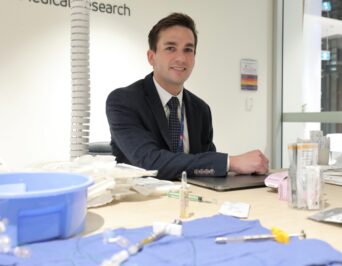
Research lead: Prof David Simmons
Research area: Diabetes
Team: Western Sydney University, Region Örebro Research Committee, Sweden, South Western Sydney Local Health District Academic Unit Fund, Western Sydney University (Ainsworth Trust)
What was the health problem that led you to carry out your research?
Gestational diabetes mellitus (GDM), the most common medical complication in pregnancy, affects ~17% of pregnant women. GDM increases the health risks of mothers, including pre-eclampsia, obstetric intervention, large-for-gestational-age babies, lifelong type 2 diabetes and cardiovascular disease. GDM also raises health risks for babies, including shoulder dystocia (an obstetric emergency), birth trauma and future obesity. Routine GDM screening currently occurs at 24–28 weeks gestation, with early testing for undiagnosed type 2 diabetes recommended for women with risk factors, such as previous GDM, high body mass index, age ≥40 years, certain ethnicities, family history of diabetes, a previous large baby and polycystic ovary syndrome. Earlier onset of GDM in pregnancy typically results in higher rates of pregnancy complications. The definition and treatment of maternal
hyperglycaemia (high blood sugar) before the 20–24 weeks screening point remains unclear. Until recently, high-quality evidence for diagnosing and treating early GDM before this point was lacking, leaving some women with earlier undiagnosed GDM and resulting in poorer health outcomes for both mother and baby.
Describe the research achievement and its impact.
The Treatment of Booking Gestational Diabetes Mellitus (TOBOGM) trial was a randomised, controlled trial (RCT) conducted across 17 hospitals in Australia, Austria, Sweden and India, that involved early intervention for pregnant women at risk of diabetes. The intervention group, who received immediate GDM treatment before 20 weeks, showed reduced adverse neonatal and maternal outcomes. Subgroup analysis showed greater benefits for women tested and treated before 14 weeks. TOBOGM research findings are influencing early screening criteria discussions and have substantial impacts, resulting in reduced need for intensive later-stage GDM treatment for mothers, reduced perineal birth injuries, and improved health of babies by reduced respiratory distress, increased breast-feeding rates and shortened Neonatal Intensive Care Unit (NICU) hospital ward stays by 0.8 days. Economically, TOBOGM research shows a cost saving of around $5,500 per woman tested before 14 weeks gestation.
How was the work unique or pioneering?
TOBOGM was pioneering because it was the first large multicentre international RCT to test early GDM diagnostic criteria and treatment in pregnant women with diabetes risk factors. It underscores the need for a personalised, life-course approach to GDM, marking a significant shift in managing the condition. Our research showed that early testing based on risk factors can identify women and babies at higher risk of adverse outcomes earlier than standard screening.
What is the broader implication of the research?
The research represents a global paradigm change in early GDM diagnosis with the potential to improve health outcomes for over 5% of the world’s pregnant women and their babies, who would benefit from early GDM treatment. It promises pregnant women with GDM better management and quality of life and reduces health complications for their babies. Further, it benefits the Australian healthcare system by greatly reducing the healthcare costs of GDM.




